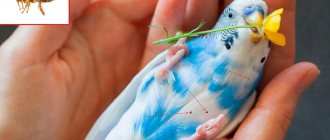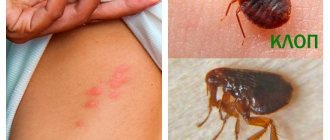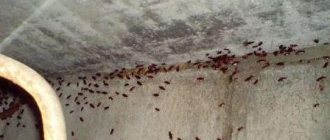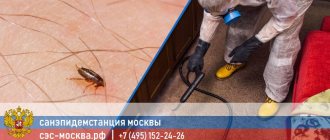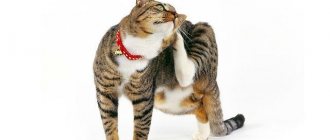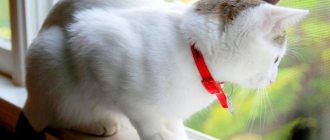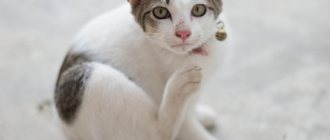Insecticides are dangerous to animal health. Therefore, when treating a cat with flea drops, there is a risk of poisoning. This is especially true for those owners who have several pets. After all, cats often lick each other and can accidentally swallow medicine. Let's find out what measures need to be taken to save animals in case of insecticide poisoning and whether it is possible to do without calling a veterinarian.
Causes of poisoning with flea drops
Most often, veterinarians indicate the following causes of poisoning in cats:
- Incorrect application of the product, namely smearing and rubbing concentrated solutions of insectoacaricides on parts of the cat’s body that are accessible to licking (belly, ears, inner thighs, tail root). The correct application of drops is pointwise in 1-2 zones along the spinal column, without rubbing. The drug spreads well and penetrates into the subcutaneous fat and hair follicles, from there it affects the tick and flea upon contact or bite.
- Treatment of weakened and sick animals, which is a complete contraindication for such manipulations. Since a small part of the active substances in flea drops still penetrates the bloodstream, a toxic effect on the cat’s liver and kidneys cannot be ruled out.
- Exceeding the dosage most often occurs when determining the pet’s weight “by eye”. Double or higher concentrations of the drug are considered dangerous. Therefore, animals need to be weighed periodically.
- The cat was washed a day after treatment, and she licked off the remaining flea drops. Poisoning occurs due to the fact that the flea remedy, which is not absorbed, is washed out over the entire surface of the cat’s fur, from where she licks it off.
- Use of canine products. Many drugs that are intended for dogs and cats are produced under the same name, but they often have different compositions. Due to cats' intolerance to certain insecticides, to which dogs do not have a similar reaction, severe poisoning may develop, even leading to death. Therefore, it is unacceptable to buy one product for different types of animals. If you need to save money, you should study the instructions for the drugs or check the name with your veterinarian.
- Handling kittens that are breastfed can be dangerous for the mother cat, as her constant licking of her babies may cause her to ingest chemicals from their fur.
- Individual intolerance to certain substances, which is typical for cats of decorative breeds. It is worth checking with the breeder about this when purchasing purebred kittens.
Prevention
Fleas can be a frustrating situation for our cats. Using flea medication is usually a last resort. However, with such risks, this may make the situation even easier.
Luckily, the ASPCA Animal Poison Control Center (APCC) has a guide to help us use flea medications correctly.
- Make it a habit to read all label information before administering medications to your pet.
- Do not use more than one medication on your pet unless directed by your veterinarian.
- Make sure your veterinarian is your primary source of information. Don't perform uneducated procedures on your pets.
- The Internet may recommend some steps that may not be entirely safe. For example, tea tree oil and garlic cause serious and potentially life-threatening symptoms in pets.
- Always make sure you double check everything before using flea medications.
- If you live in a multi-pet household and flea season has forced you to treat all the pets, take the time to treat each one. You don't want to confuse one medicine with another.
Most flea poisonings caused by a cat licking the drops usually result from failure to follow label directions. Always monitor publicly available materials provided by treatment manufacturers regarding the product's oral toxicity.
Poisoning with FOS substances and carbamates
Organophosphates (diazinon, tetrachlorvinphos) and carbamates (propoxur) are considered obsolete and toxic agents for the control of insects and ticks in cats.
Since 2004, they have been used mainly in agriculture. However, some modern pharmaceutical companies continue to produce cat drops and flea collars with these substances due to their proven effectiveness and good sales. Examples:
- flea drops “Flea Drops” from Beaphar with the active ingredient diazinon (which are no longer sold in Russia, but are available in other countries);
- insecticidal drops “Best friend Ectostop” on diazinon;
- anti-parasite collars from Hartz (tetrachlorvinphos).
Several years ago in the Russian Federation, the drug “Dana” was produced with diazinon, but today the API-SAN company has changed the composition of flea drops (fipronil + auxiliary components).
Carbamates (propoxur) are present in some flea collars for cats from the Bolfo brand, and poisoning can occur if the cat licks or chews the accessory.
Clinical symptoms
If it happens that the cat licked the flea drops with diazinon, then clinically this is expressed by the following signs:
- excessive salivation from the mouth (a characteristic sign);
- lethargy, apathy;
- frequent urge to vomit (expressed as smacking and licking);
- loose stools;
- complete lack of appetite;
- muscle weakness and convulsive manifestations;
- rapid or, conversely, weakened heartbeat (depending on the dose);
- shortness of breath, rapid breathing with an open mouth;
- constant “small” trips and thirst.
A local allergic reaction is expressed in redness of the area where drops are applied, development of irritation, itching, and scratching.
Treatment
In such cases, the first thing to do is to prevent further absorption of toxins from the skin by washing off the product using a cleansing shampoo with a strong degreasing effect.
Next, it is recommended to rinse the cat’s mouth and stomach and induce vomiting by injecting a large amount of water. After washing, sorbents (activated carbon, Smecta, Enterosgel) are introduced.
If convulsions or muscle tremors appear, you should immediately take the cat to the veterinarian, he will administer intravenous anticonvulsants to reduce agitation and other necessary drugs (Atropine, Diazepam), prescribe infusion therapy and a therapeutic diet.
Bad breath: causes
The most common cause of unpleasant odor is the active activity of pathological bacteria in the oral cavity. Diseases such as caries, periodontitis, pulpitis, periodontitis, gingivitis, stomatitis, as well as the formation of tartar can lead to persistent bad breath.
The second place among the causes of unpleasant odor is dry mouth (the medical term is xerostomia
). Mica, which moisturizes our mouth, has bactericidal properties. It kills bacteria, neutralizes their waste products, rinses and cleanses the oral cavity. If there is not enough saliva produced, bacteria are activated, resulting in an odor. Dry mouth can be a consequence of illness or taking a number of medications. It can also be caused by age: over time, the salivary glands begin to work less intensively, the composition of saliva changes, and its antibacterial properties are lost.
The smell can also be caused by ENT diseases: sore throat, chronic tonsillitis, sinusitis, runny nose.
Another cause of unpleasant odor is diseases of the internal organs. It can be:
- renal failure;
- liver failure;
- gastric diseases (gastritis, stomach ulcer);
- lung diseases.
Smoking is also a cause of persistent bad breath. The smell is caused by substances contained in tobacco smoke and deposited in the oral cavity. The only way to eliminate the unpleasant odor in this case is to quit smoking.
Poisoning with pyrethrins and pyrethroids
Pyrethrins are insecticides of plant origin, which are obtained from certain types of plants (Dalmatian chamomile, chrysanthemum, tansy). In veterinary medicine, permethrin is actively used for cats (at 0.5-1% concentration in anti-flea shampoos, collars, drops, but in other proportions it is considered poison).
This is explained by the fact that in a cat’s body, permethrin does not break down into harmless compounds (as it does in dogs) and exhibits a toxic effect on the nervous system, which leads to prolonged convulsions and death.
This is why owners should be aware that permethrin dog drops should not be used on cats, as it can kill them.
Attention! If a cat licks flea drops containing permethrin applied to a dog upon contact, this will also cause poisoning. If a cat and a dog live together in the house, then it is better to buy insectoacaricidal products with other components.
Examples of existing products for cats with permethrin (their use is permissible only if the instructions are strictly followed):
- drops on the withers “Clandestine for cats” (1% permethrin);
- “Clandestine” universal powder (0.4% permethrin);
- spray "Clandestine" for cats and dogs (0.35% permethrin);
- anti-parasitic shampoos of the “Clandestine” brand (0.4% permethrin);
- anti-flea collars “Clandestine maximum” for cats (1% permethrin);
- “Pchelodar” – universal shampoo against fleas and ticks (0.25% permethrin);
- insecticidal shampoo for cats and dogs “Fitoelita” (0.3% permethrin);
- flea shampoo “Lapushka” (0.4% permethrin).
Pyrethroids are synthetic analogues of pyrethrins. Deltamethrin and etofenprox are used for domestic cats. Examples of drugs:
- Lugovoy shampoo for cats and dogs (deltamethrin 0.01%);
- drops for fleas in cats brand “Rolf Club 3D” (etofenprox 15%);
- butox 50 concentrate for preparing a solution (deltamethrin 5%).
Recently, due to frequent cases of poisoning in cats by these substances, many manufacturers of veterinary insecticides are discontinuing the production of certain drugs or replacing the formulation.
Symptoms
So, what happens if a cat licks flea drops that contain pyrethrins and pyrethroids:
- Half of the cats experience overexcitation, which is expressed in prolonged convulsions and twitching of the limbs;
- trembling;
- saliva is produced profusely;
- there is a loss of orientation in space;
- body temperature rises;
- pupils dilate;
- temporary hypersensitivity appears;
- coordination of movements is impaired;
- heart rate increases;
- gagging is observed;
- lethargic sleep may occur.
Therapy
Pyrethrins have no antidotes, so treatment is aimed at removing toxins from the cat's body.
If the poison has entered the digestive system, then you need to start with the administration of emetics or gastric lavage. At home, you should pour warm water into the cat’s mouth to induce vomiting, then give adsorbents (Smecta, Enterosgel).
If pyrethroids are ingested externally in a toxic dose (when treating a cat with dog drops), you need to wash the animal several times with regular shampoo and then feed it with adsorbents.
If a cat has licked off flea drops and has convulsive reactions, you should immediately go to the veterinarian, he will provide first aid, prescribe appropriate treatment, or leave the animal in a hospital under his supervision.
As a rule, cats recover in 3-5 days if first aid is provided to them in a timely and competent manner.
Permethrin
Permethrin is an antiparasitic agent. Its action is based on disruption of the permeability of Na channels in insect nerve cells. Thus, permethrin has a neurotoxic effect. It is a synthetic analogue of biological substances of the pyrethroid group, obtained from flowers of the chrysanthemum genus.
Included in drops and sprays used to treat animals.
Absorption into the blood occurs through the skin when the drug is applied, or when liquid is licked from the surface of the body.
Cats are most often affected by the use of high doses of permethrin, which is part of antiparasitic products for dogs.
Poisoning with vegetable oil extracts
Some cat owners prefer to buy biological products for fleas, created on the basis of extracts of various plants (neem, mint, geranium, citronella, cloves, rosemary, tea tree, cinnamon). Such products effectively repel insects, but have virtually no effect on ticks.
Biological products are an excellent addition to classic insectoacaricides and can be the main method of protection for weakened, pregnant, lactating cats, as well as small kittens.
Examples of herbal drops on the withers:
- trademark GreenFort NEO (Ekoprom);
- a series of economical preparations Chistotel Bio (Ecoprom);
- line of VETO Pure Beaphar BIO products against fleas, ticks and mosquitoes with margosa extract;
- BIO series for cats against external parasites GAMMA;
- Good Dog Antiparasitic BIO drops;
- Natura Delix Bio Drops;
- ECO ZOOLEKAR BIO drops;
- Bio-drops AVZ “4 with a tail”;
- Drops "Rainbow BIO";
- Bio-Drops repellent Ms.Kiss;
- Flea remedy "BioVax-BIO".
However, a cat can also be poisoned by plant extracts if it ingests a large dose of the drug while licking its kittens or itself. For the first alarming symptoms to appear, a long-term interaction between the animal and the biological product is necessary (frequent treatments, a large number of kittens sprayed with the biological product, or a group of several cats that live in the same territory and lick each other).
There are pets with increased sensitivity to certain odors and extracts (congenital allergies), in which the first symptoms of poisoning may appear after a single treatment.
Typically, the problem of overdose with plant extracts is rare, and biological products have a short shelf life. Therefore, owners of city cats who take their pets out into nature try to apply drops or spray more often to avoid flea attacks.
You can also often read advice to cat owners on pet forums: “Treat your cats with biodrops every week or apply a herbal spray to their paws every day before walking outside.” Such advice contradicts the instructions for biological products, which leads to poisoning with plant extracts.
Signs of poisoning
If a cat manages to ingest plant drops against fleas, then after 30-50 minutes the following symptoms of poisoning will appear:
- excessive salivation (hypersalivation);
- refusal to eat for a day or more;
- lacrimation;
- vomit;
- muscle contractions, tremors;
- decreased body temperature (below 37.5);
- lethargy and apathy.
Deaths are quite rare with such poisonings, but are not excluded with prolonged low body temperature and decreased blood pressure.
Treatment methods
Treatment consists of eliminating severe symptoms and removing any remaining product from the cat’s fur. Namely:
- gastric lavage, stimulation of vomiting (pour in liquid, press on the root of the tongue with a spoon);
- soldering of adsorbents (activated carbon, Smecta, Enterosgel);
- drip infusion of nutrient solutions into a vein to prevent dehydration;
- for muscle twitching, Diazepam (a sedative) is administered;
- bathing in soapy water using a cleansing shampoo (to wash the drug off the skin and coat).
With this treatment, the animal will recover within 1-2 days.
Important! If a cat has an unusual reaction to a biological product, it is worth studying its composition and not buying analogues in the future.
Treatment of poisoning
The most correct and effective solution if you find signs of poisoning with insectoacaricidal drops in your pet is to contact the nearest veterinary clinic. In this case, you need to tell the doctor exactly what drug you took, in what dosage and how long ago. This information will help your veterinarian quickly select the most effective treatment.
After assistance is provided, all that remains is to adhere to the doctor’s recommendations and act in accordance with his instructions. To maintain health and restore the vitality of a cat’s body, the following is recommended:
- Diet food. Most often, doctors recommend industrially produced veterinary diets, but some doctors can create a diet based on foods available to humans;
- Liver restoration. For this purpose, doctors most often recommend Hepatovet Active due to the fact that its composition is optimal for restoring and protecting the liver of cats. It is more convenient to administer a highly palatable suspension to such fastidious animals as a cat;
- Symptomatic treatment. Here everything also depends on your attending physician. If there are still signs of illness that may be bothering your cat, your doctor may prescribe painkillers or anti-anxiety medications.
What is bad breath like?
Peculiarities of odor can indirectly indicate the source of problems.
Hydrogen sulfide smell
(the smell of rotten eggs) indicates rotting protein substances. This smell is typical for digestive problems. A persistent hydrogen sulfide odor may indicate gastritis with low acidity or a stomach ulcer.
Sourish smell
and a corresponding taste in the mouth is noted with gastritis with high acidity. This smell may appear at an early stage of the disease, when other symptoms are not yet present.
Bitter smell
and the taste in the mouth is typical of liver and gallbladder diseases. An additional symptom is the appearance of a yellow coating on the tongue.
Smell of acetone
and the accompanying sweet taste in the mouth is a characteristic symptom of diabetes.
Urine smell
from the mouth indicates a disease of the genitourinary system (primarily the kidneys or bladder).
Stool smell
from the mouth can occur due to intestinal diseases (dysbacteriosis, intestinal dyskinesia, intestinal obstruction).
Putrefactive
bad breath is typical for dental diseases (inflammatory processes of teeth and gums).
